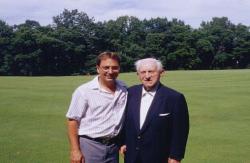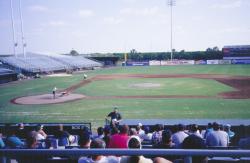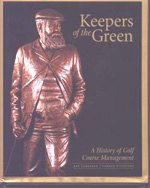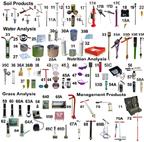|
TURF-TEC FOR GOLF COURSE SUPERINTENDENTS AND SPORTS TURF MANAGERS |
|
By: John Mascaro |
![]()
In this issue:
![]()
Editor's notes
It is with the saddest of hearts that I wish to make this announcement. One of my dearest friends, Eb Steiniger, CGCS, passed away in his sleep on Saturday April 13th, 2002. For those of you who did not have the pleasure of meeting Eb, he was a friend to all superintendents. What can I say about the man who was one of the friendliest, kindest and funniest people I have ever had the privilege of knowing. Eb had won the GCSAA distinguished service award, USGA Green Section Award, the UGSAís Piper and Oakley award as well as 100ís of other awards. In the true wit of Eb, he once joked that "he had enough awards to shingle his roof". He was
 superintendent of Pine Valley Golf Club in New Jersey for over 50 years and the true beauty of one of the most famous courses in the world is due directly to Ebís hands.
superintendent of Pine Valley Golf Club in New Jersey for over 50 years and the true beauty of one of the most famous courses in the world is due directly to Ebís hands.
During his 96 year life, he even had the privilege of having the Historical Turfgrass Equipment Museum at Penn State University named after him as well as the Town Hall in Pine Valley. Eb was the oldest member of GCSAA, having joined the association in 1932.
If you wish to make donations in Ebís honor, the family wishes donations to be made to: St. Paulís Memorial Fund, ST PAUL'S PRESBYTERIAN CHURCH, In memory of Eb Steiniger.
ST PAUL'S PRESBYTERIAN CHURCH, 433 PARK AVE, LAUREL SPRINGS, NJ 08021. Phone (856)783-1839
The industry, the profession, and all of our hearts should feel a sense of loss for this kind man. However, as his son told me, we should not morn this loss but remember him the way he would want us to, that he celebrated life!
![]()
Excuse me, but your turf needs a tissue.
Last month I had a head cold and I had the usual stuffed up nose. As I was pondering my situation and feeling sorry for myself, it occurred to me that turf probably feels the same way. Did you know that the nostrils of your grass plants are in the air spaces within the soil? If these air spaces are clogged by compaction, your roots cannot breathe.
Try putting one finger in one of your nostrils and breathe through your nose. This is what the grass roots feel like when compaction reaches 75% on the Penetrometer. Now keep your finger in one nostril and fill your other nostril with
ater. This is what your roots feel like at 75% compaction, right after you irrigate or have a rain event.
OK, before you pass out, remove the water and your finger. Feel better? Well, this is what your roots feel like after aerification and at 50% compaction on the Penetrometer.
So, next time your grass is looking stressed out after watering, remember to blow its nose.
![]()
Fact of the Day
Did you know that Poa annua has three distinct ecotypes? They are annual, biennial and perennial. The annual ecotype produces the most seeds, which cause bumpy putting surfaces and large clumps on higher mowed surfaces. Annual Poa Annua has the unbelievable ability to produce 14,000 seeds per square foot. Of those seeds, not all will germinate in one year. Of those that do, 70% will germinate in the fall and 30% in the spring.
![]()
Barrier Grief
This is reprinted from the January 2002 newsletter called "Turfnotes". If you want to subscribe to it go to
www.turfnotes.com . It was written by Bill Walsh, who works for the Southern States Cooperative, Inc.Itís hardly going to bust the budget, costing in the neighborhood of $350, but too many superintendents arenít buying. They are, instead, daring to go where Houston Couch fears to tread. "Without it," the Virginia Tech plant pathologist says of an infiltrometer, "I would not operate a golf course. Itís that simple."
Itís all about drainage. The lack thereofóand resulting anaerobiosisómay not be the root of all evil, but it is certainly at the heart of most, Couch argues. "Iíll bet you nickels to doorknobs there isnít a one in here that does not have some form of anaerobiosis on the greens back home," he lectured superintendents during Novemberís Virginia Turfgrass Council annual meeting and trade show. "The areas of greens that you are having trouble managing, many times, are due to anaerobiosis. You say, well, weíve got pythium root rot over there. For goodness sakes; what youíre seeing is anaerobiosis."
It all starts with something slowing down the movement of water through the soil, Couch explains. That could harken back to construction errors, it could be the result of an aerification program that includes improper sand selection. Prolonged rainfall could be the culprit.
|
Perc parameters |
|
| > 7 inches/hour | Excellent |
| 2.8 - 7.0 inches/hour | Good |
| 1.5 - 2.7 inches/hour | Poor |
| 0.7 - 1.3 inches/hour | Very poor |
| 0.2 - 0.6 inches/hour | Almost impervious |
| < 0.2 inches/hour | Blacktop |
"The pores become filled with water. The next thing that happens is the anaerobic bacteria begin to take over. When they grow, they develop a mucus mass on the soil particles. When this mass gets large it is called biofilm, and it will actually plug the soil."
Run an infiltration test, he urges, and do it onsite. An infiltration test done on soil samples sent to the lab is not accurate for real-life conditions because the technicians have to work with a disturbed soil sample. "What you want to know is exactly when and where you have an infiltration problem," Couch says.
The advantages that knowledge brings? You can prevent problems by close monitoring of the infiltration rates and eliminate them by aerification.
Infiltrometers are set up to measure downward movement of water, either the initial penetration of thatch or the movement of the water in the rooting mix below.
"I would do the whole course to begin with to know what the baseline is," Couch counsels, "and I would report that to my management. The minute you see a decreasing infiltration rate of about 10 percent, youíd better jolly well get someone in and find out what the problem is.
"Infiltration rates cannot be compared from one golf course to another," Turf-Tec Internationalís John Mascaro notes (see end of story). "In fact, with different soil characteristics spreading out over 200 acres, infiltration rates cannot be compared from one green to another.
"If infiltration rates are kept in a normal rangeónormal being what is consistent for that areaóthen the root health of the grass will improve. If infiltration rates are kept in a low range, roots can actually suffocate and die."
Take a member of your crew, Couch recommends, and assign him the responsibility of making measurements at set times. It may be on areas that you are trying to keep track of, zones on the green that arenít working right.
The device also tracks how well certain practices are working. "We talk about using wetting agents or surfactants to improve penetration," Couch says by way of example.
"Fine, I have no problem with that. But do you know whether they worked or not? Some people say they do, some people say they donít. You talk about naivety; you go out there and put it on, then you assume it worked. You wouldnít do that with a fungicide, because pythium will let you know in two days it didnít work. But youíll do it with infiltration.
"What you need is to do a penetration measurement, then put on the material, then go back later and try the penetration again. Otherwise, you donít know if itís working."
Want one? Infiltrometers are available through Turf-Tec International, 3669 NW 124th Ave., Coral Springs, Florida. Call (800) 258-7477 or order online at
www.turf-tec.comBlack plague
Youíre probably most familiar with anaerobiosis as black layer, Houston Couch notes. "Black layer schmack layer, Itís nothing more than an anaerobic condition that sometimes ends up with a blackening of the soil".
Youíve probably also been told that sulfur is at fault. Not so, the plant pathologist insists. "Anaerobiosis is characterized by the death of plants and also the formation of a distinct black layer, which is where the sulfur part comes in. In an anaerobic condition, the microbes that fix sulfur will increase and actually cause the layer to be black, but they have been just sitting there waiting for their turn. The dirty deed has been done before they take part.
"Iíve seen people lose their reputation in golf course maintenance because management was told that sulfur caused the problem. The superintendent was blamed when it was not the superintendentís faultóat least insofar as using sulfur was concerned. Drainage is the real culprit."
![]()
One just for the Sports Turf people.
It was pointed out to me that my newsletters favor golf courses and often leave out sports turf. Well, I know there are many similarities between growing turf on golf courses and growing turf on sports fields. I also know that there are many differences. As many of you know, and some may not, I am also well versed in the Sports Turf arenas, having run the Sports Turf Manager, Florida Chapter # 1 for the past 13 years.
So for all you sports turf people, I do write with a slant on golf, however, all the topics covered in this newsletter and previous newsletters refer to problems that affect sports turf as well as golf turf. Problems like compaction, aerification, infiltration and the like are just as important in sports turf as in golf, in fact, often they are more important.
Often athletic fields are aerified, dragged and then subjected to irrigation. Now they unleash the elephants, cleverly disguised as teenagers in soccer shorts or football pads, they proceed onto the fields and trample the thing to death. I have seen a reduction on air space in a sand based field by as much as 20% within a 7 day period. On native
 soil fields the reduction can be even more dramatic.
soil fields the reduction can be even more dramatic.
So, my tip of the month for sports fields, monitor the playing field often. Keep the soil moisture down before events so compaction can be kept to a minimum. My favorite question is "When should I aerify my fields?" my answer is always "When they need it." Monitor compaction with a Penetrometer, when compaction rises to above 65%, aerify. Also, monitor Infiltration, when infiltration falls more then 10%, aerify.
One good thing about sports turf, you do not have to drag the cores into the ground, leave the holes open and the elephants will take care of breaking up the cores.
![]()
Sports Turf Managers Association new updated web site.
If you havenít visited the Sports Turf Managers Associations website in a while, it's time to do so again. They now have an exciting site with many new features including message boards, member look up searches and many new resources.
The site is:
http://www.sportsturfmanager.com/my/shared/home.jsp
![]()
Looking back.
The best way for you to look back at our history is to purchase the new book available from the Golf Course Superintendents Association called "Keepers of the Green", A History of Golf Course Management, by Bob Labbance and Gordon Witteveen. This 268 page hard bound book has a lot of interesting facts, stories and photograph's about the history of golf course maintenance from the early days of Scotland to the current.
Keepers of the Green is the story of unsung hero's who have struggled against great odds to sculpt hostile lands into natural preserves with streams, ponds, trees and grass. Strong characters who bonded together and created a new profession and a professional organization. But it is not only the story of the people in the profession but the profession itself.
 Learn how the art of greens keeping has advances from the single-horse powered mower to hydraulically operated reels and from the water wagon to the computer operated sprinkler systems. This is the story of the men and women who started growing grass and ended up growing a profession, their wonderful mowing machines, and the tremendous contributions that they have made to the world we live and play in.
Learn how the art of greens keeping has advances from the single-horse powered mower to hydraulically operated reels and from the water wagon to the computer operated sprinkler systems. This is the story of the men and women who started growing grass and ended up growing a profession, their wonderful mowing machines, and the tremendous contributions that they have made to the world we live and play in.
To purchase the book go to:
http://www.gcsaa.orgThe exact page link is below:
https://www.golfsupermarket.net/Store/ProductInfo.asp?prod=24129&txtProductLine=GCOt&txtListingCode=638&txtRetailerCode=139&StoreCode=20Or contact GCSAA at 800-472-7878)
books@gcsaa.orgIt costs $45.00 and $30.00 for GCSAA Members. This book is a great read for anyone interested in finding out where our profession began.
![]()
Contributions to this publication.
I also want to invite all of you recipients of this newsletter that if you wish to contribute any information that you find interesting or exciting, please send it to me and I will include it along with crediting its source.
Also, if you know another Golf Course Superintendent or Sports Turf Manager that would like to receive the Turf-Tec Digest, have them forward their email address along to me. In addition, I get most of my new product ideas from Golf Course Superintendents and Sports Turf Managers who see a need in the industry that has not been filled. Be sure to look at the new product section on my web site for new additions.
http://www.turf-tec.com/Map.html
![]()
Privacy policies.
If you received this newsletter directly from
john@turf-tec.com, donít worry. I personally acquired your name by researching each golf course and sports facility individually. In addition Turf-Tec does not buy, sell, trade or share their mailing list with anyone. We also have taken security measures to insure that your name will not be passed along to other people. If, however you still do not want to receive this newsletter, simply respond to this email with the words "remove" in the subject line and your name will be permanently deleted from our list.
![]()
 If you have not received your new free 2002 Turf-Tec Catalog call us.
If you have not received your new free 2002 Turf-Tec Catalog call us.
Our toll free (800) 258-7477 or email me at
john@turf-tec.com or fill out the online form at http://www.turf-tec.com/form.html
![]()
Home / Search Site / Catalog
/ Online Ordering / Map of site / Newsletter
/ On line consult / Contact us
History / Web Designs / Request Catalog / Search Engines
*Copyright 2002